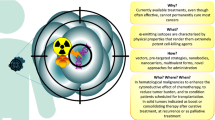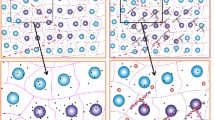Abstract
Cancer radiotherapy uses high doses of ionizing radiation (l–102Gy; 102–104rad) because only a small fraction of the absorbed dose leads to lethal double-strand breaks in DNA. These breaks are more efficiently produced by Auger electrons (1–10 eV nm−1) generated in proximity to the DNA. The energy of these electrons (on average 21 electrons for the decay of 125I) is dissipated within 10–100 nm of the Auger event and produces multiple double-strand DNA breaks1,2. A single Auger event can be lethal to a cell and is comparable to more than 105 photon absorption events in conventional radiotherapy3,4. We now report that 57Fe(III).bleomycin, administered to malignant cells in vitro and in vivo and irradiated with resonant Mossbauer gamma rays (14.4 keV), causes ablation of the malignant cells, presumably by Auger cascade, with extremely small radiation doses—about 10−5 Gy. As a basis for comparison, about 5 Gy is necessary to achieve a similar effect with conventional radiotherapy5.
Similar content being viewed by others
References
Charlton, D. E. & Booz, J. Radiat. Res. 87, 10–23 (1981).
Linz, U. & G. Stoecklin, G. 7th International Congress of Radiation Research (Amsterdam, 1983).
Hofer, K. G. & Hughes, W. L. Radiat. Res. 47, 94–109 (1971).
Feinendegen, L. E., Ertl, H. H. & Bond, V. P. Proc. Symp. Biophysical Aspects of Radiation Quality 419–430 (International Atomic Energy Agency, Australia 1971).
Hall, E. J. Radiology for the Radiologist 2nd edn, 225 (Harper & Row, Philadelphia, 1978).
Hannon, J. P., Carron, N. J. & Trammell, G. T. Phys. Rev. B9, 2791–2809 (1974).
Paoletti, J., Magee, B. B. & Magee, P. T. Biochemistry 16, 351–357 (1977).
Sakai, T. T., Riordan, J. M., Booth, T. E. & Glickson, J. D. J. Med. Chem. 24, 279–285 (1981).
Povirk, L. F., Hogan, M. & Dattagupta, N. Biochemistry 18, 96–101 (1979).
Rao, E. A., Saryan, L. A., Antholine, W. E. & Petering, D. H. J. Med. Chem. 23, 1310–1318 (1980).
Lin, P., Kwock, L., Hefter, K. & Misslbeck, G. Cancer Res. 43, 1049–1053 (1983).
Wu, H., N. Dattagupta, M. Hogan & Crothers, D. M. Biochemistry 19, 626–634 (1980).
Lawrence, J. & Daune, M. Biochemistry 15, 3301–3307 (1976).
Lawrence, J., Chan, D. C. F. & Piette, L. H. Nucleic Acids Res. 3, 2879–2893 (1976).
Paoletti, C. et al. Recent Results in Cancer Research 74, 107–122 (1980).
Stecher, P. G. (ed) The Merck Index 8th edn, 6 (Merck & Co., New Jersey, 1968).
Clarke, E. G. C. Isolation and Identification of Drugs Vol. 1, 366 (Pharmaceutical Press, London, 1969).
Burger, R. M., Kent, T. A., Horwitz, S. B., Munck, E. & Peisach, J. J. Biol. Chem. 258, 1559–1564 (1983).
Author information
Authors and Affiliations
Rights and permissions
About this article
Cite this article
Mills, R., Walter, C., Venkataraman, L. et al. A novel cancer therapy using a Mössbauer-isotope compound. Nature 336, 787–789 (1988). https://doi.org/10.1038/336787a0
Received:
Accepted:
Issue Date:
DOI: https://doi.org/10.1038/336787a0
- Springer Nature Limited
This article is cited by
-
A uranyl based coordination polymer showing response to low-dosage ionizing radiations down to 10−5 Gy
Science China Chemistry (2020)
-
Monte Carlo simulation of dose distribution in water around 57Fe3O4 magnetite nanoparticle in the nuclear gamma resonance condition
Hyperfine Interactions (2016)
-
Mössbauer evidence of 57Fe3O4 based ferrofluid biodegradation in the brain
Hyperfine Interactions (2014)
-
Effects of hematin and Mössbauer gamma-radiation on human osteosarcoma cell lines
Il Nuovo Cimento D (1996)
-
Mössbauer spectroscopy in biomedical physics research
Hyperfine Interactions (1994)





